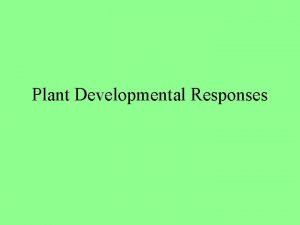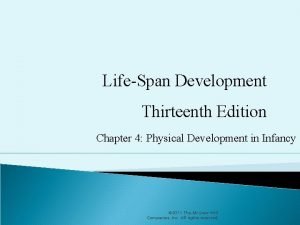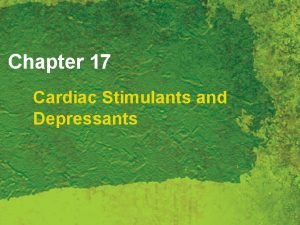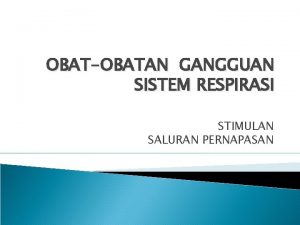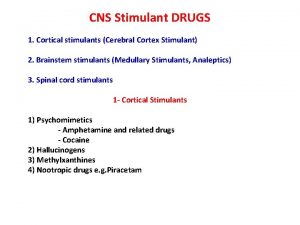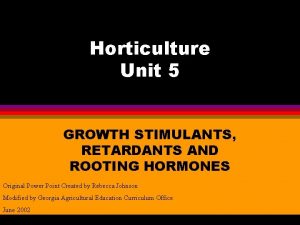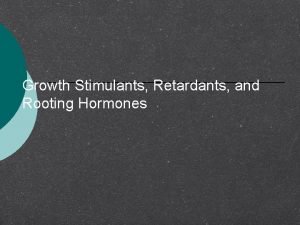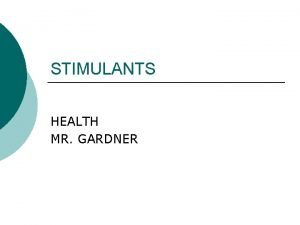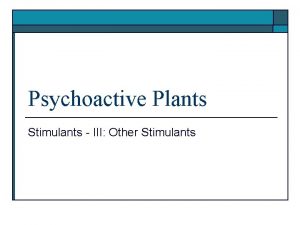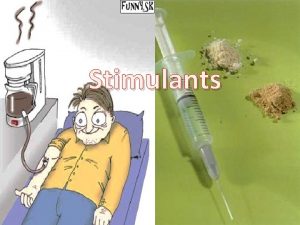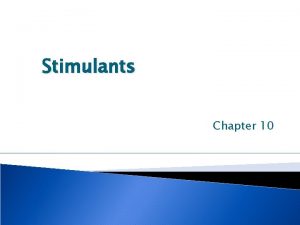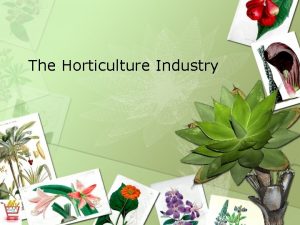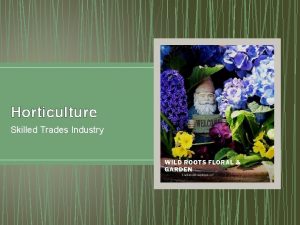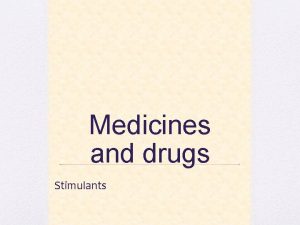Horticulture Unit 5 GROWTH STIMULANTS RETARDANTS AND ROOTING













- Slides: 13

Horticulture Unit 5 GROWTH STIMULANTS, RETARDANTS AND ROOTING HORMONES

Growth Regulating Substances l Called hormones: organic chemicals which act and interact to affect growth rate l Auxins: accelerate growth by stimulating l Gibberellins: stimulate growth in stem l Cytokinins: stimulate cell division (only l Inhibitors: inhibit seed germination, stem cell enlargement and leaf by cell elongation works with auxins present) elongation and hasten ripening of fruit.

Growth Hormones l l l Organic chemicals principally produced by actively growing plant tissue such as short tips and young leaves. They move throughout the plant and can be found in many parts. They react with one another.

Apical Dominance l l l The terminal bud secrets chemicals which inhibit or prevent growth of lateral buds. This causes the plant to grow tall and not send out side branches. Seems to be a genetic program directing the plant to grow above competing plants. Once the plant reaches flowering age, the terminal bud becomes a flower bud and the chemicals are no longer secreted. Pinching the terminal bud has the same effect and side branching occurs sooner.

Major Discoveries l l Chemical and natural stimulants that cause plants to grow taller or faster Chemical retardants that cause plants to grow slower Hormones that cause plants to root faster Dwarfing rootstock for fruit trees

Chemical Stimulants l l Enables plants to grow taller. Most common is gibberellic acid Gibberellic acid causes the stems of plants to stretch out The nodes (the joints at which bulbs, leaves and branches) are further apart

Natural Stimulants l l l Chemical known as alcohol Triacontanol Found in alfalfa and has been known to nursery men for 30 years. Stimulation is brought about by mulching with alfalfa hay or by watering plants with an alfalfa tea

Chemical Retardants l l l Used to retard the growth of plants making them shorter and more compact and therefore more attractive. One of the newest applications for growth retardants is on lawns, a chemical called “Limit” is used new and it restricts grass growth for 6 to 8 weeks. A new plant regulator called “Sumagic” reduces the height of plants by inhibiting production of the hormone Gibberellic acid. (which cause stems to elongate)

Rooting Hormones l l l When propagating plants from cuttings, it is very important that they root as quickly as possible Indoleacetic acid (IAA) is a natural plant hormone that causes roots to form Chemical hormones, indolebutyric acid (IBA) or naphaleneacetic acid (NAA) are the most common used today.

Rooting Hormones l l Rooting hormones are either mixed with talc and used as powders or mixed with liquid and used as a wet dip All rooting hormones should contain a fungicide.

Dwarfing Rootstock l l l As the cost of labor has increased, growers are looking for smaller trees. Discovered trees from certain types of roots, do not grow as large and bear fruit earlier. A complete series of rootstock known as malling rootstock was developed.

Commercially Used Plant Growth Regulators

Student Activities l l Complete self-evaluation at the end of this unit. Using nursery catalogs and books, make a list of available dwarf fruit trees and details.
 Positive vs negative gravitropism
Positive vs negative gravitropism Intermodal perception
Intermodal perception Stepping reflex
Stepping reflex Newborn reflexes psychology definition
Newborn reflexes psychology definition Cardiac stimulants and depressants
Cardiac stimulants and depressants Uterine stimulants definition
Uterine stimulants definition Respiratory stimulants
Respiratory stimulants Cortical stimulants
Cortical stimulants Define growth analysis
Define growth analysis Monocots eudicots
Monocots eudicots Primary growth and secondary growth in plants
Primary growth and secondary growth in plants Chapter 35 plant structure growth and development
Chapter 35 plant structure growth and development Step growth polymerization vs chain growth
Step growth polymerization vs chain growth Geometric growth graph
Geometric growth graph
